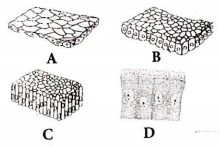 Multiple Choice Questions
Multiple Choice QuestionsIn frog heart, there are cardiac muscles which consists of fibres called
Purkinje fibres
myonemes
telodendria
columnae carnae
Malphigian tubules are
excretory organs of insects
excretory organs of frog
respiratory organs of insects
endocrine glands of insects
Inner lining of blood vessels is formed by
ciliated epithelium
squamous epithelium
cubical epithelium
columnar epithelium
In frog chromosome number is reduced to half
when 2nd polar body is separated
when 2nd polar body is divided
when 3rd polar body is separated
when 1st polar body is separated
D.
when 1st polar body is separated
Each primary oocyte undergo two maturation divisions, first meiotic and the second meiotic division.
In the I-meiotic division, the primary oocyte divides into two unequal haploid daughter cells - a large secondary oocyte and very small first polar body.
In II-maturation division, the first polar body may divide to form two second polar bodies. The secondary oocyte again divides into two unequal daughter cells, a large ootid and a very small second polar body. The ootid grows into a functional haploid ovum.
The I meiotic division is reductional and II meiotic division is equational division.
The figure shows different human tissues labelled as A to D. Which option gives the correct identification of the label, its location and one feature.

D-Unicellular glandular epithelium, goblet cells, secrete saliva
B-Squamous epithelium, walls of blood vessels, form a diffusion boundary
A-Cuboidal epithelium, ducts of glands, secretion and absorption
C-Columnar epithelium, lining of stomach, secretion and absorption
Pacinian corpuscles occur in the skin of certain parts of body in mammals. These are
type of glands
pain receptors
naked tactile receptors
encapsulated pressure receptors.
